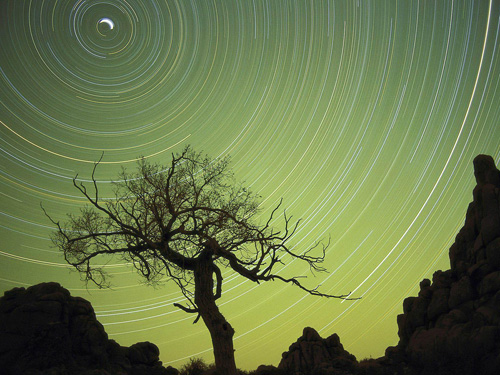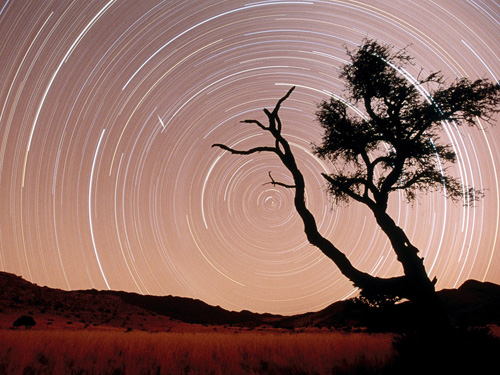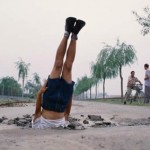
One of the simplest forms of astrophotography is capturing star trails. From helpful tips and tricks to required equipment and recommended camera settings, I will try to cover in this article the basic photography technique and equipment needed for star trails photography.
1) Avoid Light Pollution
Starlight comes from millions of light years away, and is quite faint. A bright light in the vicinity of the camera would cause over-exposure and make the star trails invisible (that’s the reason why you can’t see the stars during daytime). The city has its streetlights and lights from other sources, contributing to a lot of ‘light pollution’; hence the first requirement for a good star trail photo is to be as far away from a city as possible. Remember the moon too is quite a good source of light, especially the full moon, which is best avoided. A partial moon would be helpful though, to get the foreground details captured.
2) Pick a starry night
Yea right ! I know it is obvious but still wanted to pin-point it! Also you might have a better visibility on a moonless night or when the moon is still low on the horizon.
3) So let’s take a look at what you should take with you
– Camera: Don’t go without it
– Lens: You will need the fastest lens you have. Well pack 2 one long and one wide. I use a Canon EF 24-70mm f/2.8 (at 24mm) as my wide and an Canon EF 85mm f/1.8 as my long.
– A few memory cards: Star trails is the type of photography when you’d expect to shoot a lot of pictures and keep only a few so make sure to have enough storage with you
– A spare battery: Since we’re going to shoot long exposures you’d better have one or two freshly charged spare batteries with you. Specially that at night temperature goes down and batteries drain faster.
– Remote shutter release:If you don’t have one you can always use your camera’s timer.
– Camera cover: You’d probably need to protect your camera from dew and condensation.
– Tripod: This one should rarely be left behind.
– Flash light: Make sure to include on in you bag, you’ll need it not only to lighten you way.
– Warm clothes & gloves: They might come in handy if it gets too cold.

4) Camera settings
ISO Settings: You will need to crack up your ISO settings at at least 800. Although it is very common to use ISO 1600 and 3200 for these shots it is a safe bet to start doing test at ISO 800 and check if there is a need to go higher
Noise reduction: If your camera has a noise reduction feature make sure to turn it off or else you’ll end up waiting for your camera to finish processing unable to shoot between every 2 pictures.
White Balance: Knowing that a star is a far away sun then, logically, the correct White Balance should be daylight. However this WB setting will generally lead to a very odd sky color, I’ve had much better results using Tungsten white balance.
Mirror lockup: To minimize camera movements to the max you will want to enable the mirror lockup and, if you don’t have a cable release, enable the timer on your camera.
Shoot Raw: RAW is much more flexible in editing afterward and specially effective for tweaking white balance settings.
Go wide and include a foreground
It is interesting to include an building/tree/rock or any other object or scene in the foreground. It gives a sense of familiarity to the viewer as seeing a normal scene in an incredible way.
Go long for abstract effect
Another option would be to compose your shot to include only stars. This will lead for a more abstract effect.
Get Creative with light
If you chose to go for a wide angle shot you can also use the flashlight to “light paint” the foreground. This will lead to have a nice foreground with details instead of only a black form.
5) Taking The Shot
Now that we’ve taken care of camera settings, we come to the actual shot.
For cameras that have a ‘Bulb’ shutter speed setting: Set your camera to ‘Bulb’ and set an exposure time of at least 20 minutes. That would give you a small star trail. Check for composition, exposure and foreground. If satisfied, try out longer exposures in the range of 30 minutes to 3 hours to get much longer trails. A point to remember with digital cameras is that longer exposures would result in excessive noise. At a 2-3 hour exposure, the noise can be overpoweringly annoying. The solution is to take multiple photos with smaller exposure times.
Now all you need to do is wait for the clouds to go away and wrap up warm in the winter months and get out there and take images. Don’t be afraid to play with the camera settings as each location and subject will need some adjustments to get the best image.
Once you have some images captured take them back to the computer and take a look, with luck, you will have something to make you smile. Remember to make some notes on what settings you’ve used so that next time the setup becomes easier and you can spend more time photographing.
via




